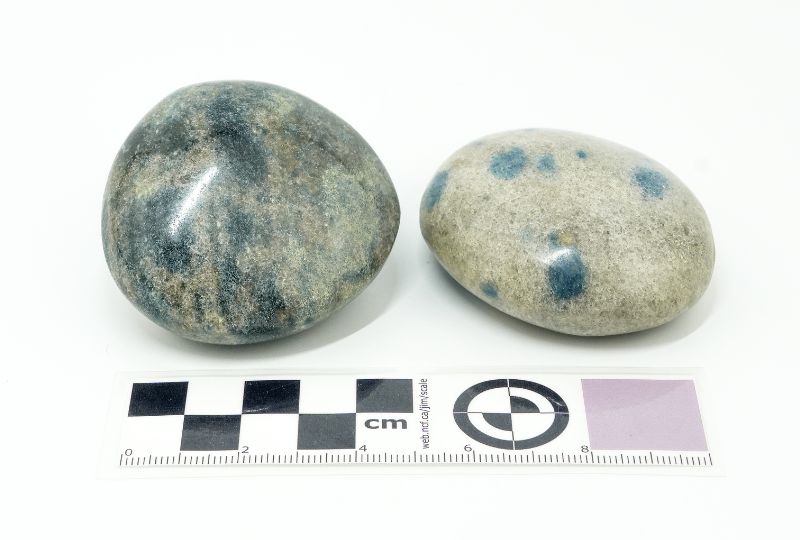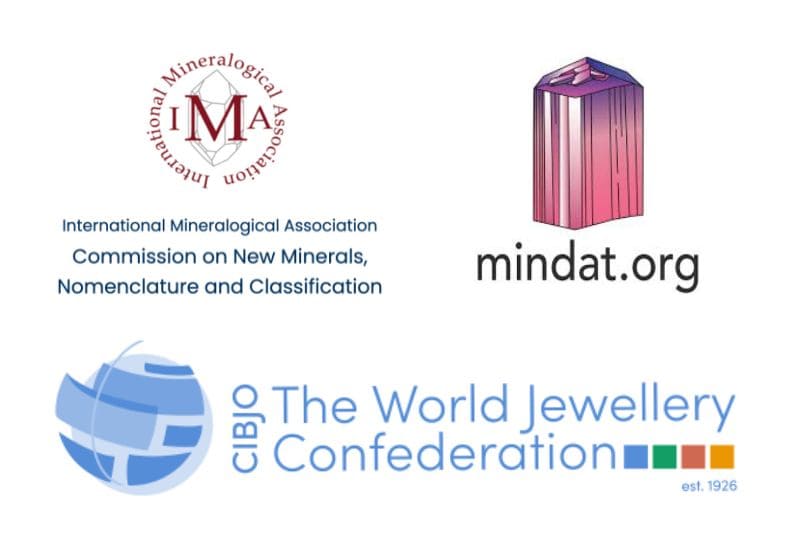Analysis: apatite in cleavelandite or not?

By now there are a lot of stones on the market with blue spots, under a lot of different names. One name that has recently resurfaced a lot is “apatite in cleavelandite”. Polished stones or objects such as spheres and towers of a gray stone with blue speckled spots. Some time ago I received a few hand stones of this from a vendor in my community to study more closely. I now have the results back from the lab, I give a comprehensive summary here.
Different names, different stones
So these stones with blue flecks are currently sold primarily as “apatite in cleavelandite”. When a stone with this appearance is shown on social media platforms to ask what it is, that is also the most frequently given answer. But, it is also frequently called ‘K2 jasper’ or even ‘new K2 jasper’ by Chinese sellers. Occasionally, you will also come across other names for the same material, which have been used since its introduction to the market in 2020/2021. For example, it is also sold as ‘iolite in quartz’, ‘Blue Polka Dot Stone’ and ‘Blue Spot(ted) Rockcrystal’, ‘trolleite in quartz’ or even ‘blue Paraiba quartz’.
Based on its appearance, it can be quickly determined that it is definitely not a K2 jasper/stone. K2 jasper is a commercial name for granite with round patches of blue azurite found on the K2 located in the border region between Pakistan and China. By the way, the name K2 jasper is misleading because it has nothing to do with jasper, it is a granite composed of quartz, albite, muscovite and thus azurite.


‘K2 jasper,’ a granite with secondary flecks of azurite
Trolleite in quartz is also a gray stone with blue spots but has a slightly different appearance. Trolleite is a green to blue aluminum phosphate mineral, currently mainly on the market in cut objects from Brazil. It is related to and co-occurs with lazulite and scorzalite.


Trolleite in quartz on the left (Brazil) and scorzalite in schist on the right (Portugal)
A name that is not at all correct for the material under investigation is “blue Paraiba quartz”. That is a commercial name for quartz with inclusions of the mineral gilalite. Named after the site of Paraiba, Brazil and thus not after the color of blue Paraiba tourmaline as is regularly stated (and which, by the way, is also named after the same site). Under magnification, the blue and green inclusions resemble the Medusa jellyfish, hence also called Medusa quartz.


“Paraiba quartz” (gilalite in quartz), left facet stones (Gem Agency photo), right detail shot (Jacob W photo, New Era Collections via Mindat)
Previous analysis of “Blue Spot(ted) Rockcrystal”
Back in 2022, I also investigated a cut stone similar to the material now analyzed, which at the time was sold as “iolite in quartz” and “Blue Spot(ted) Rockcrystal,” from Madagascar. Incidentally, these stones are still available today under the latter name from a Dutch wholesaler. The gray matrix of that stone is clearly much coarser than the two I have now analyzed and also clearly has all the characteristics of quartz. After analysis, this turned out to be lazulite in quartz and not iolite.


“Blue Spot(ted) Rockcrystal” analyzed in 2022 was found to be coarse quartz with fine grains of lazulite
Apatite in cleavelandite or not?
But if all these different names are not correct, what is it? At least no apatite in cleavelandite!




Analysis in an external lab confirmed that both tumble stones (dark and light) consist of a matrix of mainly quartz and the blue grains have been identified as lazulite. In the dark stone, orthoclase has also been found in the matrix and in the light stone traces of hematite. There is no indication that the material is not natural (composed or treated/dyed).
In connection with the texture of the stones (a direction is discernible) and the presence of orthoclase and hematite in addition to lazulite and quartz, this is probably a metamorphic rock, a so-called metaquartzite. Similar material is found in Saronara Quarry, Ambatofinandrahana District, Amoron’i Mania, Madagascar.
Advice regarding naming in the mineral business
The simplest and most correct designation is lazulite in quartz. Because of the texture and composition of the rock, it could also be called lazulite in meta quartzite.
The names ‘apatite in cleavelandite’, ‘iolite in quartz’, ‘trolleite in quartz’ or ‘blue Paraiba quartz’ for this material are incorrect and therefore should no longer be used. The commercial names ‘Blue Polka Dot Stone’ or ‘Blue Spot(ted) Rockcrystal’ suit the appearance and can be used provided that the composition of ‘lazulite in quartz’ is also stated.






Responses